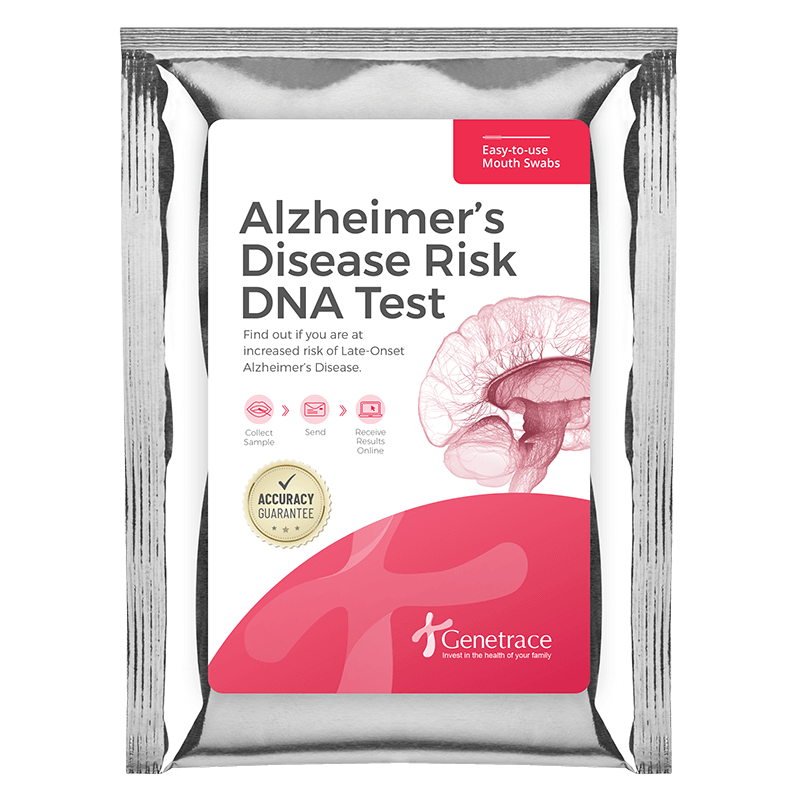About the Test
Your Alzheimer’s Disease DNA Test Results

Find out if you are at risk - get tested
| Test Type | Testing Time | Fee |
|---|---|---|
 DNA Alzheimer's Disease Test
DNA Alzheimer's Disease Test
| 4 to 6 weeks |
$195
Click Here to Order Kit |
All orders received before 3pm PST / 6pm EST are shipped out the same business day. All orders received after 3pm PST / 6pm EST or on weekends or holidays are shipped out the following business day. 24/7 online status check and account management available for all tests.
The Alzheimer’s Disease DNA Test Results Report
Alzheimer’s disease is a progressive brain disorder characterized initially by memory loss and later by the loss of thinking, reasoning and behavioural abilities. There are both early-onset and late-onset forms of Alzheimer’s disease. The late-onset form occurs in 90% of Alzheimer’s disease cases and the first symptoms generally appear after 65 years of age.
The APOE gene is the biggest genetic risk factor linked to the late-onset form of Alzheimer’s disease. The late-onset Alzheimer’s disease APOE genetic test determines the APOE alleles that an individual has inherited. These alleles indicate whether an individual has an increased lifetime risk of developing late-onset Alzheimer’s disease. To follow are all of the possible allele results and their associated risk:
Neutral (homozygous e3 / e3)
A neutral result means that the person carries two copies of the APOE e3 allele. This is the most common allele and is a neutral allele, meaning there is no increased or decreased risk of Alzheimer’s with the presence of this allele. There is a 100% chance that this person will pass the neutral APOE e3 allele to the next generation and there is no chance that this person will pass the high risk e4 allele to the next generation.
Reduced Risk (homozygous e2 / e2)
A reduced risk (homozygous) result means that the person has inherited two copies of the APOE e2 allele and may have a slightly reduced risk of Alzheimer’s. There is a 100% chance that this person will pass the reduced risk APOE e2 allele to the next generation and there is no chance that this person will pass the high-risk e4 allele to the next generation.
Reduced Risk (heterozygous e2 / e3)
A reduced risk (heterozygous) result means that the person has inherited one copy of the APOE e2 allele and one copy of the neutral APOE e3 allele. This person may have a slightly reduced risk of Alzheimer’s. There is a 50% chance that they will pass the reduced risk APOE e2 allele to the next generation and a 50% chance that they will pass the neutral APOE e3 allele to the next generation. There is no chance that this person will pass the high-risk e4 allele to the next generation.
Increased Risk (heterozygous e2 / e4 or e3 / e4)
An increased risk (heterozygous) result means that the person has inherited one copy of the APOE e4 allele and one copy of either the APOE e2 or APOE e3 allele. This person has a 3-fold increased risk of developing Alzheimer’s. This person has a 50% chance of passing the defective gene (APOE e4 allele) to the next generation. If two heterozygous affected individuals have children, there is a 25% chance that their children will be normal, a 50% chance that their children will also be heterozygous affected, and a 25% chance that their children will inherit two defective genes and be at an even higher risk of developing Alzheimer’s.
Increased Risk (homozygous e4 / e4)
An increased risk (homozygous) result means that the person has inherited two copies of the APOE e4 allele, one from each parent. This person has 10 – 15 times the normal risk of developing Alzheimer’s. There is a 100% chance that an affected individual with a homozygous genotype will pass the APOE e4 allele to the next generation.
